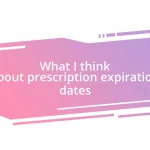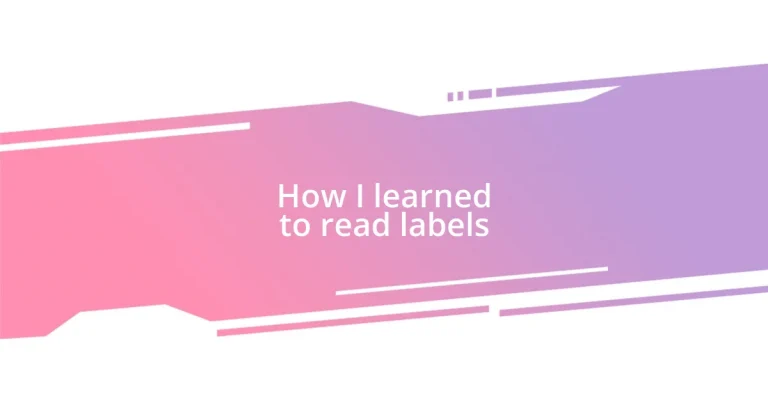Key takeaways:
- Understanding labels empowers informed choices and enhances the shopping experience by connecting with personal values.
- Key components like serving size, ingredient lists, and nutritional information are crucial for making healthier decisions.
- Practicing label reading skills transforms grocery shopping into a rewarding and engaging activity, fostering a deeper awareness of food choices.
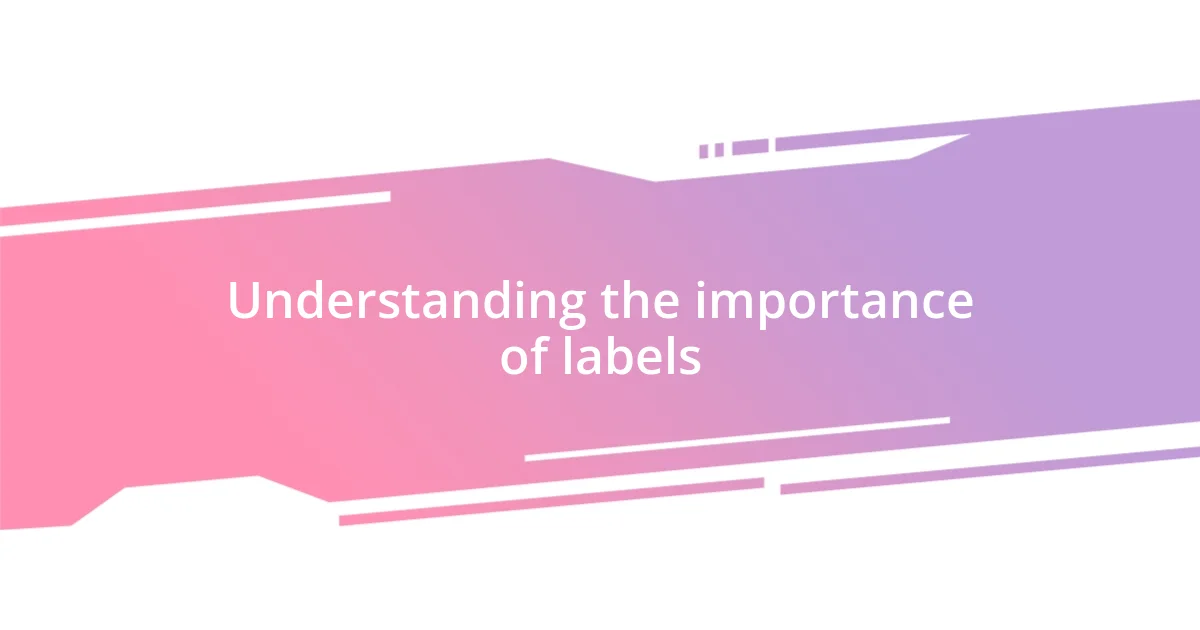
Understanding the importance of labels
When I first started paying attention to labels, it felt like unlocking a secret code. I remember standing in my kitchen, confused by the ingredients on a cereal box. Why did it matter if high fructose corn syrup was listed or not? Understanding these little snippets of information greatly empowered my choices, guiding me toward healthier options that aligned with my values.
Labels are not just functional; they are a window into transparency. They tell the story of what we’re consuming and allow us to make informed choices. I’ve had moments where I chose a product simply based on its label—like the time I opted for an organic brand after reading about its farming practices. The emotional relief of knowing I supported ethical sourcing brought an unexpected satisfaction that significantly enhanced my shopping experience.
Have you ever felt that rush of confidence when you confidently select a product because you understand its label? For me, it transformed grocery shopping from a mundane chore into an engaging exploration. Each label became a conversation starter, helping me to connect not just with my food but with the values they represent. This shift in perspective underscored how labels can impact our lives beyond nutrition; they influence our choices, beliefs, and overall well-being.
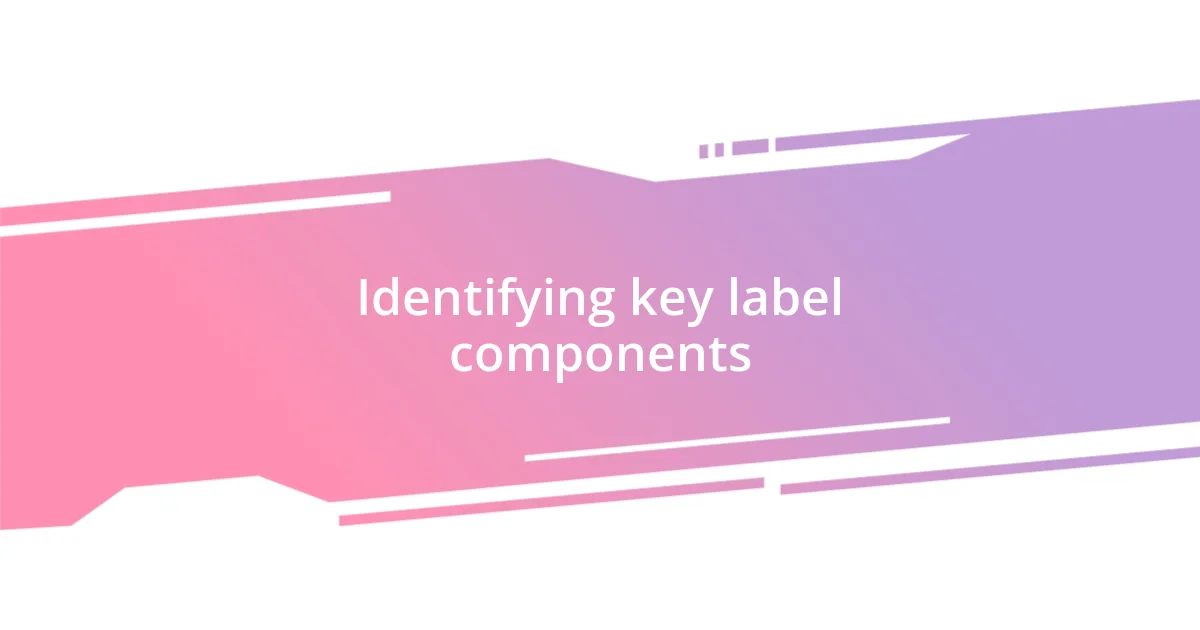
Identifying key label components
Identifying key components on labels can initially feel overwhelming, but it’s essential for making informed choices. For instance, when I first encountered the term “serving size,” I realized how it dramatically influenced my understanding of nutrition. I remember being shocked when I discovered that a bag of chips contained multiple servings. Suddenly, I had to rethink how I viewed portion control and its impact on my overall health.
Then there’s the ingredient list, where transparency reigns supreme. I recall the moment I spotted “natural flavors” on a label and felt a mix of curiosity and skepticism. I wanted to know exactly what that meant for my body. This prompted me to further investigate and understand that these vague terms could sometimes cover up less desirable additives. Labels are like a puzzle that, once pieced together, reveal the bigger picture of what I am putting into my body.
Lastly, don’t underestimate the importance of nutritional information. When I learned to read the amounts of fat, sugar, and protein, it was as if a light bulb went off. I distinctly remember switching to a brand of yogurt that boasted high protein content, which not only satisfied my dietary goals but also kept me full longer. This newfound awareness transformed my shopping habits and fueled my passion for healthy living.
| Label Component | What to Look For |
|---|---|
| Serving Size | Understand how much you’re actually consuming |
| Ingredient List | Look for familiar ingredients; avoid vague terms |
| Nutritional Information | Focus on fats, sugars, and protein amounts |
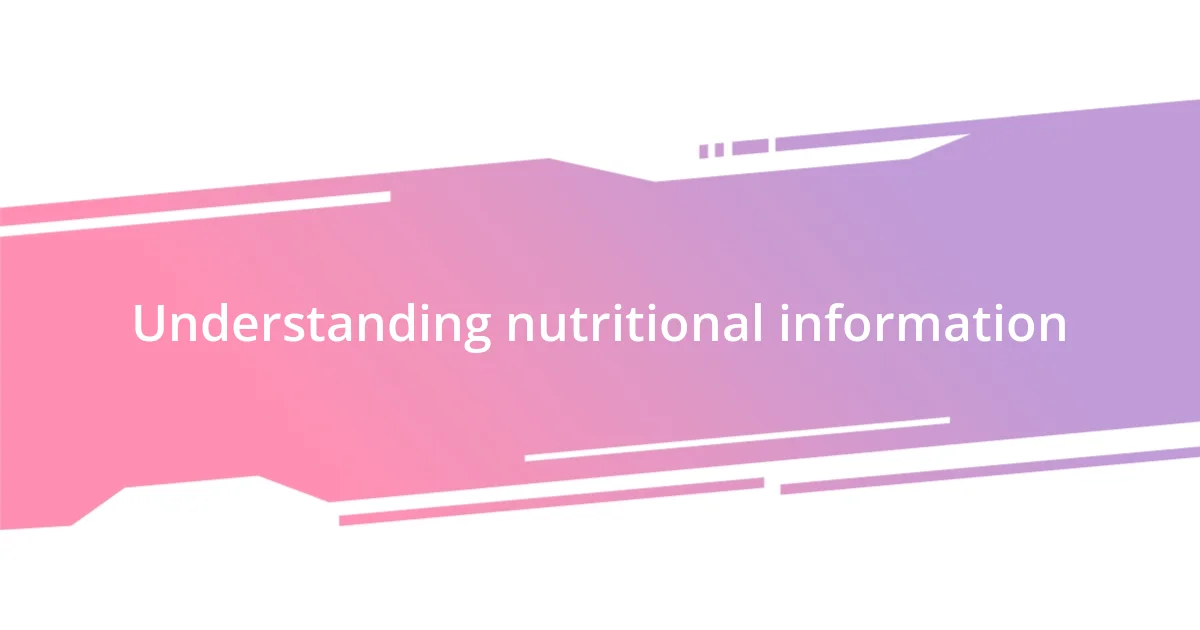
Understanding nutritional information
Understanding nutritional information can feel like unraveling a mystery novel, filled with twists and surprises. I recall feeling a surge of empowerment the first time I checked the sugar content in my favorite granola bars. I was taken aback to see how much added sugar was hidden inside. It made me rethink my choices. I realized that this knowledge not only affected what I purchased but also how I perceived the food I consumed daily.
Here’s what I’ve learned about interpreting nutritional information:
- Calories: Knowing the caloric content helps me balance my meals throughout the day.
- Total Fat: I pay attention to both saturated fats and trans fats, as they play a significant role in heart health.
- Sugars: I look for total sugars and added sugars, since excessive sugar intake can lead to various health issues.
- Protein: Understanding protein content guides my choices, especially regarding satiety and muscle maintenance.
- Vitamins and Minerals: I love to choose options rich in essential nutrients, ensuring a well-rounded diet.
By honing in on these aspects, I’ve transformed my shopping routine. I can now make choices more aligned with my health goals, ensuring that even small purchases resonate with my commitment to well-being. Each label’s nutritional breakdown feels like a personal conversation with my food—one where I’m in the driver’s seat.
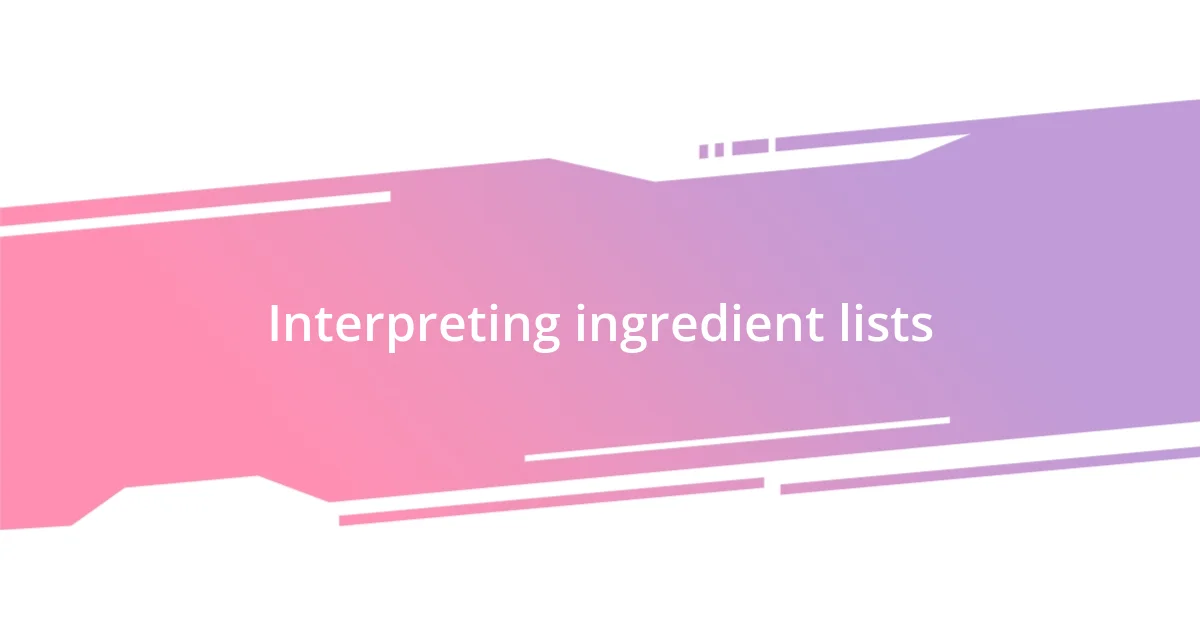
Interpreting ingredient lists
Interpreting ingredient lists can feel like deciphering a secret language. I remember the first time I picked up a box of cereal and saw ingredients like “maltodextrin” and “calcium carbonate.” At that moment, I was both intrigued and a bit confused. What exactly are these compounds doing in my breakfast? That experience pushed me to research unfamiliar ingredients, leading me to appreciate the importance of knowing what I’m really eating.
I’ve learned to prioritize ingredients that I can recognize. One day, upon switching to a brand that proudly displayed oats, nuts, and honey as its main components, I nearly felt a sense of joy. It was refreshing to find a product that didn’t have a lengthy list of chemicals. This taught me that simplicity often translates to better quality. It’s a lesson I carry into my shopping trips—if I can’t pronounce it or if it sounds like a science experiment, I often put it back on the shelf.
Sometimes, I find myself wondering why there’s not more transparency in food labeling. It’s astonishing how many products include vague terms like “spices” or “artificial flavors,” prompting me to dig deeper. I recall a time when I stumbled upon a sauce with an alluring label, only to find it packed with preservatives. That experience instilled in me a sense of responsibility—my health is worth the extra effort to read and understand what I’m consuming. Each ingredient tells a story, and I’ve come to appreciate my role as the narrator in my health journey.

Recognizing allergens and sensitivities
Recognizing allergens and sensitivities in food labels can seem daunting at first. I vividly remember the moment I learned my friend was allergic to peanuts. It struck me how something as simple as a jar of peanut butter could pose such a risk. That experience opened my eyes to the importance of thorough label reading and made me acutely aware of the potential dangers lurking in the ingredients list.
It’s not always straightforward, though. I once picked up a muffin at a local café, thinking it was a safe choice, only to discover it contained tree nuts—a fact buried in the fine print on the label. That mishap taught me to look beyond just the larger packaging and scrutinize every detail. Now, I approach every label with a sense of vigilance, ensuring that allergens like gluten, dairy, and soy don’t slip by unnoticed. Have you ever found a product that seemed harmless, only to discover it contained an ingredient you were avoiding? It’s those moments that highlight the importance of being proactive, rather than reactive.
I’ve also come to appreciate how understanding allergens goes beyond simply avoiding specific ingredients. It’s about developing a holistic awareness of what my body needs to thrive. For instance, after discovering my sensitivity to certain preservatives, I sought out more natural alternatives. The relief I felt when I switched to homemade sauces was profound. Each time I cook with fresh ingredients, I’m reminded that recognizing allergens is not just about safety—it’s about honoring my body. Understanding what fuels me has transformed the way I approach food altogether.
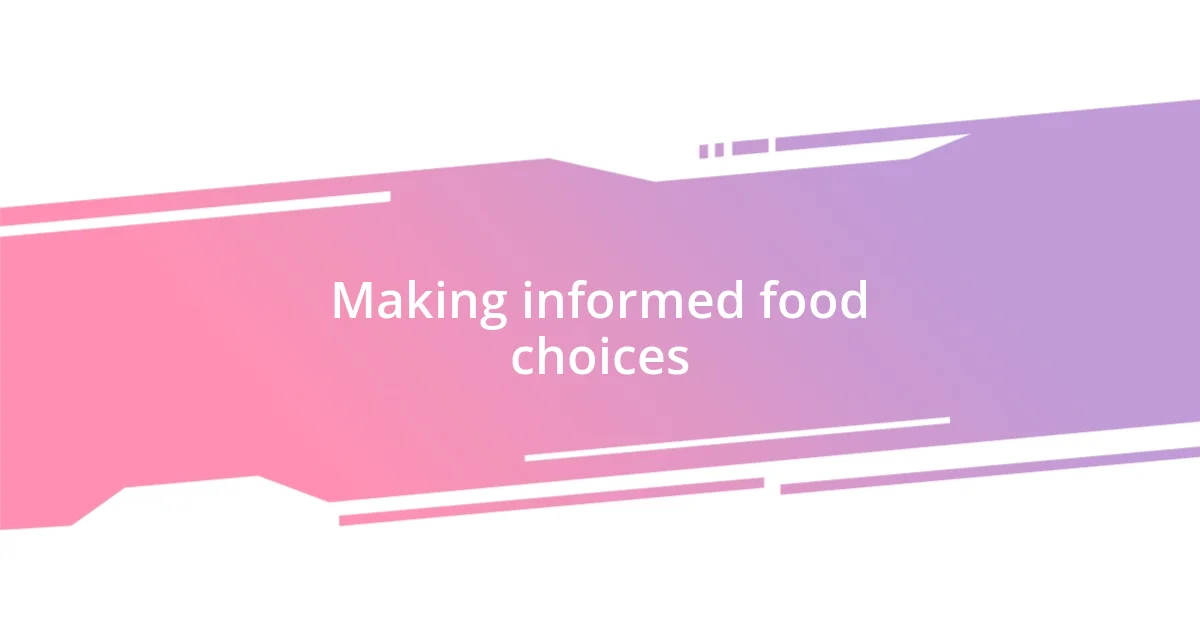
Making informed food choices
Making informed food choices hinges on understanding nutrition labels and what they signify for our health. I remember the first time I consciously examined the nutritional information of granola bars. Noticing the soaring sugar content made me question my habitual morning snack. Did I truly want to start my day with such a sugary jolt? That realization nudged me to seek alternatives that fueled my body rather than load it with empty calories.
Navigating the world of food choices isn’t just about avoiding harmful ingredients, but also about recognizing what our bodies truly need. For instance, when I learned about the benefits of fiber, I started opting for foods high in this nutrient. One day, while grocery shopping, I stumbled upon a delicious-looking pack of whole-grain crackers. I could almost taste their crunch before even buying them! Understanding that fiber aids digestion and keeps us feeling full helped me appreciate the choice I made. Have you ever felt that surge of satisfaction when you select something that’s good for you?
Moreover, I often reflect on how quickly our lifestyle choices can shift our health. A few years back, I decided to track my food intake for a week, only to be shocked by how many hidden sugars and unhealthy fats crept in. This insightful exercise made me realize that awareness is the first step toward change. As I swapped out processed snacks for fresh fruits and nuts, I not only felt physically better, but I also experienced a newfound clarity. Each meal became an opportunity to nourish my body, making informed food choices a rewarding habit that enriches my everyday life.
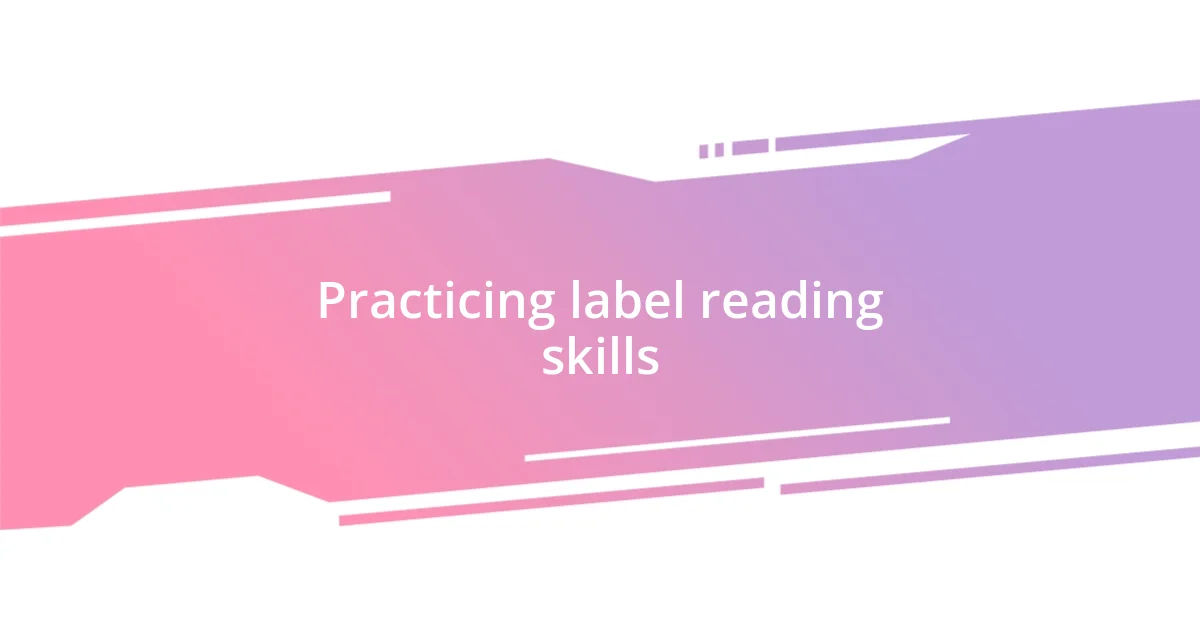
Practicing label reading skills
Practicing label reading skills is like building a muscle; the more I do it, the stronger I become. I remember my first grocery trip where I dedicated a whole afternoon to scanning labels. It felt overwhelming at first, but as I compared similar products, I started to see patterns. Did you know that some brands use deceptive packaging that makes their snacks seem healthier than they are? It was my wake-up call to be vigilant.
Each trip since then has turned into a small adventure. I often challenge myself to find at least three new items with clear labels and nutritional values. It’s amazing how this practice not only enhances my food knowledge but also turns shopping into a treasure hunt! The thrill when I discover a product that fits my dietary needs and has a transparent label is undeniably rewarding. Have you ever found a gem of a snack that exceeded your expectations? I certainly have, and those moments now feel like personal victories.
Sometimes, I even bring my friends along. I’ve found that discussing labels with others brings out insights I might’ve missed. One time, while in the cereal aisle, we stumbled upon a brand that boasted about whole grains but had hidden sugars. My friend was shocked, and so was I! Engaging in these conversations has made label reading not just a solitary task but a shared experience, which adds a layer of accountability. Who knew that practicing label reading could strengthen not just my knowledge, but also my friendships?



